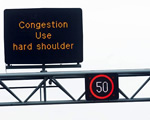 Go to main content
Go to main content
Archive Website of the UK government
Please note that this website has a UK government accesskeys system.
Main menu
Page menu
Travel and transport

Managing motorway congestion

Managed Motorways and Controlled Motorways are two similar schemes that are currently managing congestion on some of England's busiest routes. Find out where they are, how they work and what makes them different from the usual road management systems. You can even try out a simulation.
What Managed Motorways are
A Managed Motorway is a system of electronic traffic management that includes opening up the hard shoulder to drivers as an extra lane when needed. The system uses electronic message signs to set variable speed limits and open or close lanes.
How a Managed Motorway is different from a normal motorway
A Managed Motorway has:
- lightweight overhead gantries to carry CCTV cameras and electronic signs and signals
- lane-specific signals showing speed limits and whether or not a lane is open
- driver information signs to warn drivers of incidents or congestion ahead
- digital safety cameras to enforce speed limits
- entry or exit signs to show drivers when they are entering or leaving a Managed Motorway area
- emergency refuge areas with emergency phones, spaced at approximately 800 metres (these are places to stop in an emergency when the hard shoulder is in use)
- CCTV cameras giving full coverage of the Managed Motorway area so operators can see the hard shoulder and spot any traffic incidents quickly
- sensors buried in the road surface
How a Managed Motorway works in normal conditions
When traffic conditions are normal, the signs are blank and the normal rules of motorway driving apply.
What happens when congestion begins to build up
When congestion builds up or there is an incident like a crash:
- sensors under the road detect slower-moving traffic
- the computer system calculates the most appropriate speed for traffic
- the new speed limit appears on the overhead signals
- a red cross appears over the hard shoulder to show it should not be used except in an emergency or breakdown
This reduces speed and smoothes the traffic flow, with less stop-and-start driving. Because the same speed limit is shown over each lane, it also reduces the need for drivers to overtake.
What happens with severe congestion
If congestion continues to build up, the sensors alert the operator in the Highways Agency regional control centre. The operator can open the hard shoulder to drivers within minutes (after checking on CCTV that the hard shoulder is clear and safe).
When the hard shoulder is opened:
- a message appears on the overhead signs telling drivers they can use the hard shoulder
- a speed limit appears on the hard shoulder (the same speed limit as is displayed over the other lanes)
Overhead signs on Managed Motorways
For more information about electronic signs used above the lanes on Managed Motorways, see 'Overhead electronic signs'.
Safety on Managed Motorways
Where the Managed Motorway system is in use, there are emergency refuge areas with emergency phones linked to the regional control centre. These areas are for drivers who break down or need to stop in an emergency only - just like the hard shoulder on a normal motorway.
If there is an incident such a crash, a single lane can be closed to traffic in minutes. This means emergency vehicles can reach the scene quickly and with minimum disruption.
Managed Motorway area: the M42 and Birmingham intersections
The first stretch of motorway to be converted to Managed Motorway was the M42 between junctions 3A and 7 near Birmingham.
This section is now being expanded to include other stretches of motorway that intersect around Birmingham (in the area known as the Birmingham Box). When work is complete this will include:
- larger areas of variable speed limits around the Managed Motorway from the M42, M40 and the M6 - these will improve flow, especially where motorways merge
- full Managed Motorway system on the M6 junctions 4 to 5 and 8 to 10
Work is also under way to expand the Managed Motorway on the M42 at junction 5. This will mean that the hard shoulder can be used as an extra lane, not just on the main motorway but also at the junction. You can find detailed information on this on the Highways Agency website.
You can also download an evaluation report of the M42 Managed Motorways project (which was called Active Traffic Management or ATM).
Try the Managed Motorway experience
To get a taste of the features you might experience on a stretch of Managed Motorway, follow the link below.
Your feedback
If you have used a section of Managed Motorway, the Highways Agency would like to know what you thought of it. Follow the link below to complete a feedback form.
What are Controlled Motorways
Controlled Motorways have all the features of Managed Motorways but not the facility to open the hard shoulder as an extra driving lane. For this reason they do not need emergency refuge areas.
If you break down on a Controlled Motorway you should follow the usual safety rules for motorway breakdown.
The first Controlled Motorway - the M25
The Western section of the M25 was the first Controlled Motorway in England. It has had a variable speed limit and incident control system since 1995. This has been upgraded as the volume of traffic continues to increase.
The Highways Agency has produced a detailed leaflet explaining how the M25 Controlled Motorway section works. You can download it below.
 Facebook
Facebook Twitter
Twitter StumbleUpon
StumbleUpon Delicious
Delicious Reddit
Reddit